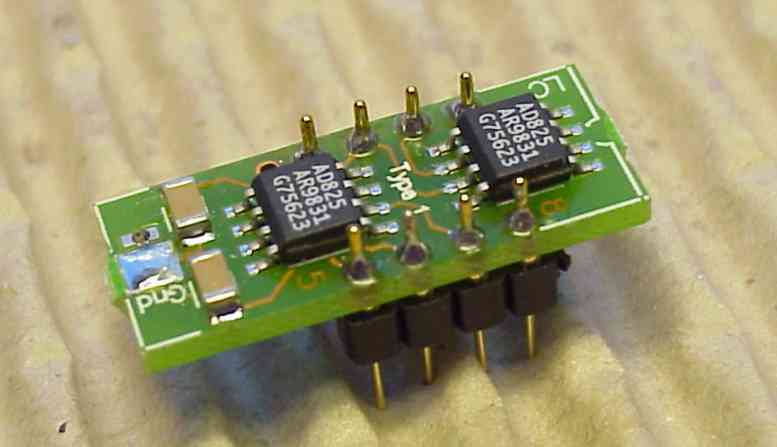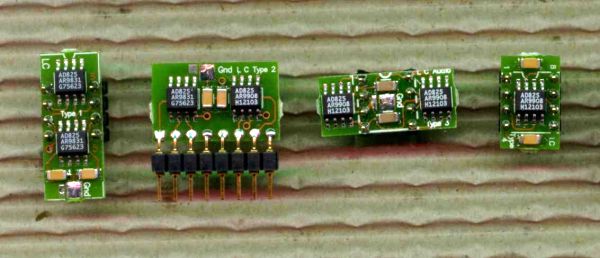Analogue Stage Upgrade with Operational Amplifiers.

With many CD players, including the more expensive models, the analogue stage is driven by operational amplifiers. Unfortunately, these op-amps tend to be of a poor quality and a sound degradation becomes inevitable. The effect on sound quality is an aggressive midrange in powerful passages. In complex music sections the instruments merge together causing the sound clarity to become unclear. Further more, poor quality op-amps can sometimes be responsible for a cold and edgy sound. These less expensive and inferior quality op-amps are typically one of the following;
NE5536, NJM5532, NJM2114, NJM4560, NJM4570, NJM4580, AD712, LM833.
If these components are changed to a better type, the following results can be achieved;
Treble and midrange becomes more liquid and easy flowing.
Detail becomes optimal at both low and high levels.
CD player sounds less aggressive and gains a warmer, more natural
sound.
After our analysis of data sheets and listening tests of different op-amps,
we have found which parameters are important for sound quality. These include
low THD, settling time and the open loop gain (as low as possible). Other
parameters, such as input noise and unity gain stability, are also of importance,
if a more practical use of the device is required. We found two op-amps
with very promising sound qualities. These being LM6172 from National Semiconductor,
and the AD825, from Analog Devices.
The LM6172 is the less expensive, with a direct drop-in capability.
However, the LM6172 has a harder and colder sound, making it more suitable
for CD players with high frequency bit-stream converters. The AD825 has
the properties and sound quality to fit into most CD players with success.
We also developed a totally different approach, the ZAPfilter, which is better than even the best op-apms, but also comes at a higher pricetag. The AD825 still gives very good value for very little money.
Other op-amps we tested were found to have some potential, but did not come up to the high end level. These were;
OP627, OP2132, AD811, LT1122.
Further down on our list of test results we placed these components; AD712, OPA275, OP2604, NE5534, AD846. Any component that achieved a performance result below these others would not be suitable in good audio equipment.
As AD825 is only available from Analog Devices in SMD version, we have
built appropriate modules to carry it in a standard DIP footprint. So now
it is possible to fit AD825 into most CD players, where DIP, SIP or single
DIP packages are normally used.
On the module - supplied with gold plated contact pins - there are
also the appropriate decoupling capacitors on the power supply rails. We
produce four different modules, replacing the majority of all known types
of operational amplifiers.

Type 1..DIP Dual Opamp, replaces NE5532, NJM2114, JRC4580, AD712,
OPA2132, OP275, OPA2604 a.o.
Type 2..SIL Dual Opamp, specially for use in TEAC VRDS10, VRDS10SE
and Kenwood 7090.
Type 3..DIP Dual Opamp, reversed specially for use in Cambridge
DAC3 and Rotel RCD 971.
Type 4..DIP Single Opamp, Replaces NE5534, LT1122, OPA627, AD811,
AD844, a.o.
Compare AD825 data with the most commonly used types:
(THD data listed, even thoung we do not consider it very important for sound quality.)
| AD825 | NE5532 | AD712 | OP275 | OPA2604 | OPA2132 | NJM2114 | Effect on sound quality in a CD player or D/A Converter: | |
| Unity Gain bandwidth | 41 MHz | 10 MHz | 3 MHz | 9 MHz | 20 MHz | 8 MHz | 15 MHz | At this frequency the gain is only 1, and the distorsion of the opamp is very high. The more this parameter is higher that the highest audible tones, the better You may expect a clear and blur-free treble. Higher is better! |
| Slew Rate | 125 V/uS | 9 V/uS | 16 V/uS | 22 V/uS | 25 V/uS | 20 V/uS | 13 V/uS | Slew rate limitation can lead to the midrange and treble getting aggressive at high signal levels, and also loss of details at complex music passages. Higher is better! |
| Settling time | 80 nS | n/a | 1000 nS | 200 nS | 1000 nS | 700 nS | n/a | Settling time is the period in nS (Nano Seconds 1/1 000 000 000 second) it takes the opamp to track a transient in the signal. If it is too slow, loss in detail is evident in the higher tone regions. Lower is better!. |
| THD @ 1 kHz | 0,00012% | n/a | 0,0003% | 0,0006% | 0,0003% | 0,00008% | 0,0005% | THD is low enough on all the types, that we do not consider it to be the most important factor.. |
| THD @ 10 kHz | 0,00014% | n/a | 0,002% | 0,004% | 0,002% | 0,0002% | 0,004% | THD is low enough on all the types, that we do not consider it to be the most important factor. However note that the types with the higher slew rate, does not have a higher distorsion level at 10k than at 1k. This is a great advantage! |